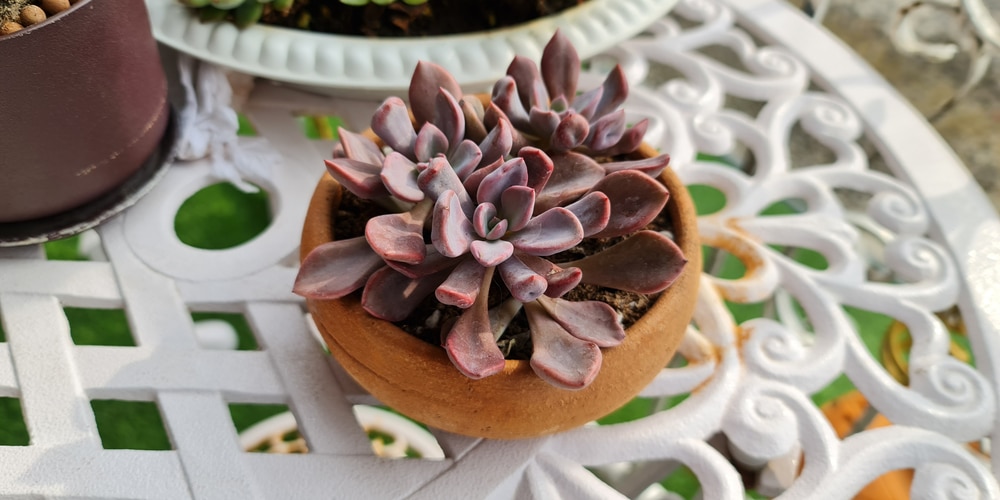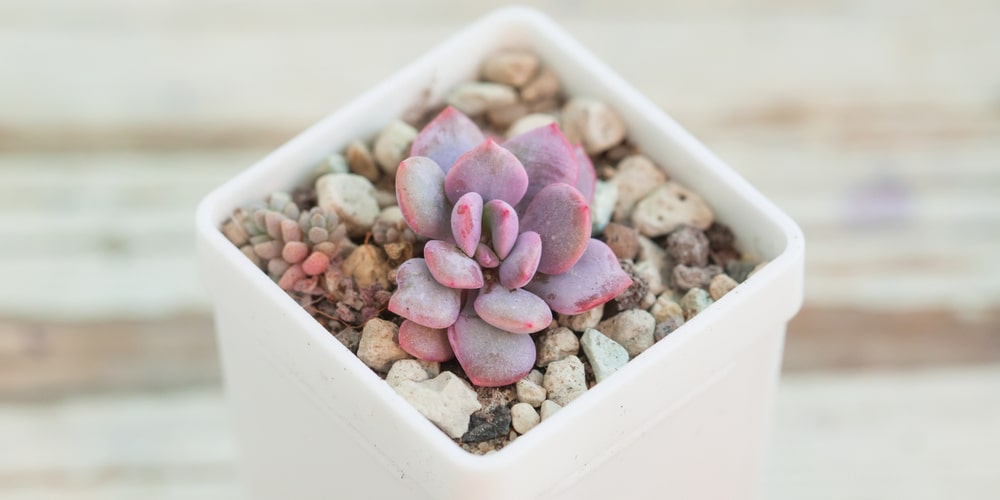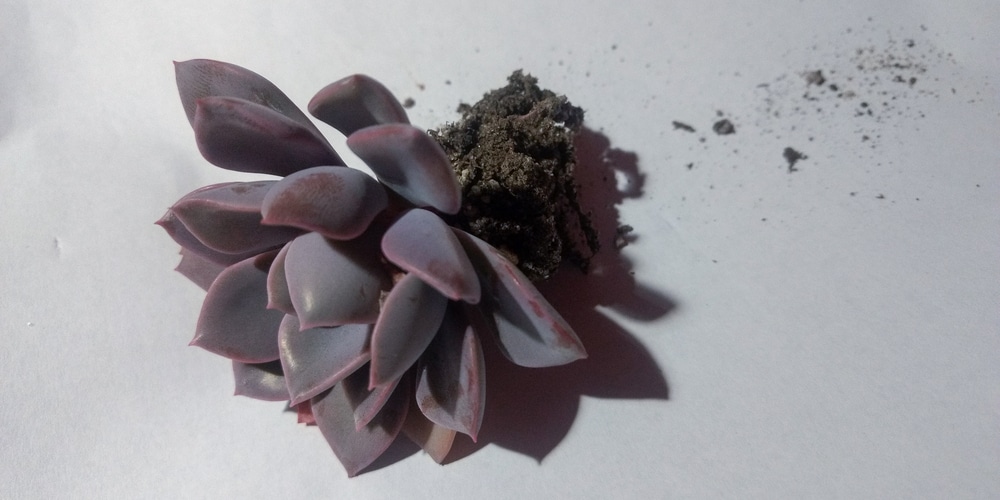The Graptoveria Debbie succulent is a thing of beauty. Its leaves are a deep green, with a purple hue that seems to change in the light. Prized for its color and its easy-to-care-for nature, the Graptoveria Debbie is a popular choice for both indoor and outdoor gardens.
You can easily recognize this plant, thanks to its rosette shape and its thick, fleshy leaves. The center of the rosette is often lighter green or even pinkish-white, while the tips of the leaves are a deep purple.
Don’t let its small size fool you – this little plant is a powerhouse. It can tolerate long periods of drought and still look amazing. Whether you live in a hot, dry climate or somewhere with cooler temperatures, the Graptoveria Debbie will do just fine.
| Botanical Name | Graptoveria ‘Debbie’ |
| Common Name | Lilac Spoons |
| Plant Type | Perennial |
| Flower Color | Apricot-colored flowers |
| Size When Mature | 8 – 12 inches wide |
| Bloom Time | Summer |
| Sun Requirements | Full sun, tolerates some shade |
| USDA Hardiness Zones | 9 – 11 |
| Soil PH Range | 6.5 – 6.8 |
| Soil Type | Succulent potting soil, acidic, well-draining |
| Water Needs | Low |
| Native Area | Mexico and Central America |
What You Need to Know About Graptoveria Debbie
Characterized by its rosette shape and rippled leaves, the Graptoveria Debbie is a succulent that originates from Mexico. It’s a member of the Crassulaceae family, including well-known plants such as jade plants, sedums, and echeverias.
The Graptoveria genus comprises around 40 different species, all of which are native to Mexico, Guatemala, and Honduras.
Its leaves are thick and fleshy, with a rippled texture. They grow in a rosette shape, and the plant can reach up to 12 inches in diameter. Its most stunning feature is its color. The leaves are a deep purple, almost black, with pinkish-purple margins, which change to red or burgundy in direct sunlight.
The Graptoveria Debbie flowers in the summertime. The blooms are small and white, and they grow in clusters. Although the flowers are not particularly showy, they have a sweet fragrance that is reminiscent of citrus.
How to Care for Graptoveria Debbie
The Graptoveria Debbie is a relatively easy plant to care for. It is tolerant of neglect and can survive in various conditions. However, it will thrive and flower more prolifically if given the proper care. Here’s everything you need to know about growing and caring for a thriving Graptoveria ‘Debbie’:
Light
As part of the succulent family, the Graptoveria Debbie is used to growing in bright, direct sunlight. It would receive several hours of sunlight each day in its natural habitat. This pretty succulent thrives and does pretty well in the sun to partial shade. A bit of afternoon shade protects the leaves from sunburn in the hot summer months.
Morning sunlight is the best for this plant as it helps to bring out the deep colors in the leaves. However, the Graptoveria Debbie can also tolerate low light conditions. If you are growing your plant indoors, place it near a south-facing window. It’s the most ideal location for the plant to get plenty of bright light.
Water and Soil Needs
It’s normal to assume that this plant needs a lot of water because of its sunlight exposure. The truth is, the Graptoveria Debbie is quite drought tolerant. In its natural habitat, it grows in sandy, well-drained soils. This succulent requires very little water to survive.
When you do water your plant, make sure to use room-temperature water. Water the soil directly, taking care not to get water on the leaves.
Ensure that the plant gets a good soaking, but avoid overwatering and waterlogging the soil. Doing this may result in root rot, which is sometimes fatal to succulents. Once its roots have deteriorated, it’s very difficult to save the plant.
It’s best to wait until the soil has completely dried out before watering again. The frequency will depend on the temperature and humidity levels in your area. In hot, dry climates, you may need to water every 10 days or so. In cooler areas with high humidity, you may only need to water every month.
If you’re unsure whether or not your plant needs water, here’s a quick trick. Stick your finger into the soil. Make sure that your finger is going all the way down to the second knuckle. If the soil is dry at that depth, it’s time to water. If soil sticks to your finger, it means that it’s still moist, and you can wait a little longer before watering.
It flourishes in almost any soil pH but thrives best in slightly acidic soils with a pH level between 6.0 and 6.8.
Temperature Requirements
Ideally, it thrives in temperatures 40˚F to 100˚F. It’s best to keep your Graptoveria Debbie on the cooler side during the winter months. It can tolerate temperatures as low as 30˚F, but it may lose some of its leaves. When the weather dips below 20˚F, the plant will start to experience frost damage.
If you’re growing your Graptoveria Debbie indoors, make sure that the temperature in your home doesn’t dip below 40˚F. It’s also important to keep the plant away from drafts, heaters, and air conditioners, as these can cause the leaves to drop.
It does best in USDA hardy zones 9 to 11 but can survive in zone 8 with the right care.
Fertilizer
Don’t underestimate the plant’s delicate colors and branches. They are pretty hardy and can survive with little or minimal fertilizing. The best fertilizer to use on a Graptoveria Debbie is a succulent fertilizer. Feed them only once a month using a half-strength solution during the growing season. Avoid feeding them during the winter months, as they are primarily dormant at this time.
Common Diseases
These succulents are popular for gardeners and indoor plant hobbyists because they are relatively easy to take care of and are not susceptible to many diseases. However, like all plants, they can still be affected by a few common problems.
One of the most common problems that these plants face is root rot. Root rot is caused by overwatering, resulting in the plant’s roots deteriorating. If you think your plant has root rot, the best course of action is to remove it from its pot and inspect the roots. If brown and mushy, the plant has root rot and needs to be treated immediately.
Cut away any affected roots with a sterile knife to treat root rot. Then, replant the Graptoveria Debbie in a pot with well-draining soil. If the plant is still showing signs of stress, you can also add some water-retaining crystals to the soil.
Graptoveria Debbie Propagation
The best way to propagate Graptoveria Debbie is through its leaves or offsets. Offsets are small plantlets that are usually found around the base of the mother plant. To propagate from offsets, simply gently twist them off from the main plant and pot them up in well-draining succulent soil.
To propagate from leaves, start by carefully removing a healthy leaf from the stem. Place the leaf on a piece of paper towel and allow it to callous over for a few days. Callousing is when the leaf forms a protective layer over the cut. Once the leaf has calloused, you can pot it up in succulent soil.
Water your newly propagated plants sparingly, as they are still quite delicate. Only water them when the soil has completely dried out. Gradually increase watering as the plants start to grow and establish themselves.
Related Article: Do Succulent Leaves Grow Back?



